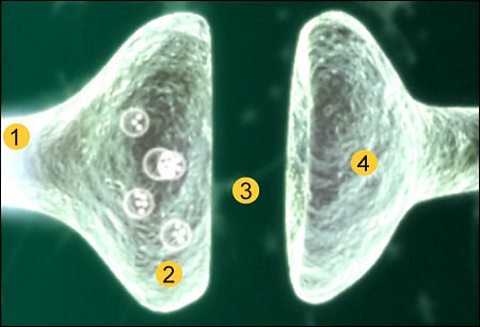Neurones
The human nervous system consists of:
- the central nervous system (CNS)The part of the nervous system made up of the brain and spinal cord. (CNS) - the brain and spinal cord
- the peripheral nervous systemAll the nerves in the nervous system except those in the central nervous system (eg those not in the spinal cord and brain). - nerve cells that carry information to or from the CNS
The nervous system allows us to react to our surroundings and coordinate our behaviour.
The conditions inside our body must be carefully controlled if the body is to function effectively. The conditions are controlled in two ways with chemical and nervous responses.
All control systems include:
- Cells called receptorOrgan, tissue or cell that detects a stimulus., which detect stimulusSomething that sets off a reaction in the nervous system, for example, light, heat, sound, gravity, smell, taste, or temperature. These changes in the environment are detected by receptors in an organism. The plural is stimuli. (changes in the environment).
- The coordination centre, such as the brain, spinal cord or a gland such as the pancreas, which receives and processes information from receptors around the body.
- effectorThe organ, tissue or cell that produces a response. bring about responses, which restore optimum levels, such as core body temperature and blood glucose levels. Effectors include muscles and glands, and so responses can include muscle contractions or hormone release.
Nerve cells
Nerve cells are called neuroneNerve cells. They carry an electrical message or impulse when stimulated.. They are adapted to carry electrical impulses from one part of the body to another.
A bundle of neurones is called a nerve.
There are three main types of neurone:
- sensory neuroneThe nerve cell that transmits electrical impulses from receptors in the sense organs to the CNS.
- relay neuroneThe nerve cell that transmits electrical impulses from sensory neurones to motor neurones.
- motor neuroneThe nerve cell that carries electrical impulses from the CNS to effectors such as muscles or glands.
They have some features in common:
- the cell body that contains the nucleusThe central part of an atom. It contains protons and neutrons, and has most of the mass of the atom. The plural of nucleus is nuclei., organelles and most of the cytoplasmThe living substance inside a cell (not including the nucleus). of the neurone
- one or more dendronsExtensions found at the end of a nerve cell., which carry nerve impulses towards the cell body, and an axonThe long part of a nerve cell along which the electrical signal quickly moves., a single fibre that carries nerve impulses away from the cell body
- a fatty, myelin sheath, that covers and insulates the neurone
Sensory neurones carry electrical signals - nerve impulses - towards the central nervous system (spinal cord and brain). The signal starts in a receptor which detects a change.
Relay neurones carry nerve impulses within the central nervous system.
Motor neurones carry nerve impulses away from the central nervous system. The neurone ends in either a muscle or gland, which are effectors.
Receptors to effectors
The flow chart summarises how information flows from receptors to effectors in a coordination system.
Stimulus ā receptor ā coordinator ā effector ā response
The diagram summarises how information flows from receptors to effectors in the nervous system.
Synapses
Neurones do not connect physically with one another. Where neurones meet, there is a small gap called a synapseA tiny gap at the junction between two nerve cells, which nerve signals must cross..

When a nerve impulse travels from one neurone to another:
- an electrical impulse travels along the first neurone.
- when it reaches the end of the neurone, chemical transmitter molecules called neurotransmitterChemical involved in passing nerve impulses from one nerve cell to the next across a synapse. are released
- the neurotransmitters diffusionThe movement of molecules from an area of higher concentration to an area of lower concentration. across the synapse and bind with receptor molecules on the membrane of the second neurone
- this stimulates the second neurone to transmit the electrical impulse
Learn more about the human nervous system with Dr Alex Lathbridge.
Listen to the full series on “óĻó“«Ć½ Sounds.
In this podcast, learn the key facts about the human nervous system. Listen to the full series on “óĻó“«Ć½ Sounds.